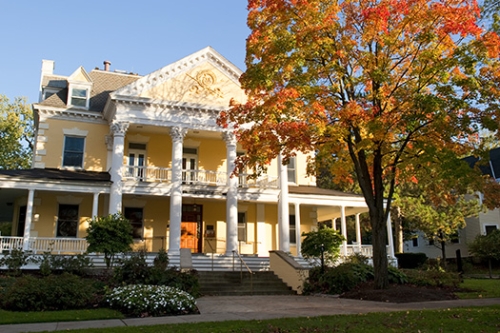Posted by Jim McLaughlin, Athletics Director
If there was ever a great moment to explore the nature of athletics at small liberal arts colleges – and the range of offerings – this would have to be it.
In 2012 the Union men’s ice hockey team made it into the Frozen Four for the first time in our school’s history. We defeated UMass-Lowell to get there, winning the NCAA Division I East Regional title and advancing to the semifinals tomorrow in Florida.
Our entire 2,100-student campus is obviously crazy with pride, and it’s a perfect example of how competitive our athletes can be – going head-to-head with much larger programs at “big hockey” state schools like Minnesota and Michigan. It’s a real David and Goliath story, and we’re making national news. So our recent success got me thinking. . . what’s the larger message about athletic opportunities at small liberal arts colleges? What should guidance counselors tell aspiring student athletes about what sports means on a campus like Union?
Our men’s hockey team is very prominent right now, but I like to tell prospective students we have something for everyone– from dodgeball to yoga, rugby to Frisbee. In addition to varsity sports, we also offer student-organized competitive club sports and intramural sports. I also like to say that if we don’t have it, and students want it, we’ll start it. A couple of years ago, a few students expressed interest in sailing, which we didn’t offer at the time. But we have a river and a boathouse, so we put a program in place, and the students ran with it. This is one great advantage of liberal arts schools when it comes to sports: if you want to play, there’s usually a way to make it happen.
When it comes to varsity sports, Union’s scene – and probably that of most small liberal arts colleges – differs greatly from big state schools. Sports are very important here, a deep part of the fabric and culture of our institution. But we don’t offer any athletic scholarships. All of our student athletes are considered for merit scholarships and financial aid, just like everyone else. That can make recruiting a challenge, but it’s not a deal breaker for premier athletes. We also get a fair amount of talented walk-ons.
A significant number of students play varsity sports here at Union: 600. That’s more than a quarter, and I’m sure other liberal arts colleges see similar numbers. This level of participation would be unheard-of at larger schools, where only a minute percentage of students have the opportunity to play top-tier sports. That’s not to say our teams aren’t competitive – they definitely are. And the high number of students immersed in a rigorous daily athletic regimen creates a certain culture. When you play sports at a smaller college, you’re surrounded by peers on the same daily “circuit” – classes, icing and rehab, practice, dinner and evening study. It’s very easy to bond and stay focused.
Unlike larger schools, we also don’t sequester our varsity athletes in their own dorms and dining rooms. This integrated approach – along with the sheer number of students playing – creates a strong culture of support and school pride. Games are the places to be on Friday and Saturday nights, drawing a huge number of students, faculty and administrators. When students do something impressive on the field or win academic achievement awards on their teams, the campus community knows and celebrates them.
Union and schools like us also place a real emphasis on academic excellence, reflected by our athletes’ high GPAs. The stereotypes about coaches pressuring professors to pass failing athletes before big games just don’t apply here. Many schools say this, but at Union and other prestigious liberal arts colleges, it’s really true. Academics are our number-one priority.
All of our coaches are completely on board with this perspective. I always refer to our coaches as teachers, mentors and educators – they’re just in a different “classroom.” They often have even more contact with students than any dean, professor or administrator, so their leadership is crucial. We make sure the right people fill these roles, and that they deliver a consistent message, stressing academic excellence.
Our student athletes get no special treatment in the academic realm. Yes, professors will work with their schedules. But we like to say there’s no place to hide at Union. Athletes take the same small classes as everyone else. Ironically, we’ve noticed our student athletes actually perform better academically in-season than out. The rigor and structure of their sports-season days seem to inspire a consistent discipline. Many of our student athletes also appreciate our trimester system, which makes it easier for them to dedicate a trimester to international study or similar opportunities without missing part of their sports season.
So if your students are serious about sports, tell them to consider a small liberal arts college. Who knows? They might find themselves playing – or cheering – for their team at a national competition like the Frozen Four.
